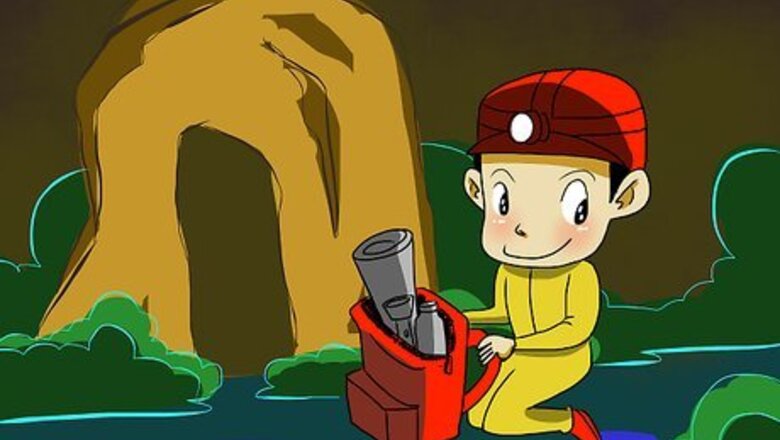
views

Enter a cave well-prepared. Caving is inherently dangerous, but you can reduce the risk by learning proper caving techniques, bringing the right equipment, and knowing how to use your techniques. Especially if you’re new to caving, don’t go in without an experienced guide, and never explore caves alone. Always make sure you notify someone where you will be and when you expect to return so that they can notify rescuers if you can’t. Bring warm, NON-COTTON (like polypro or polyester) clothes and a plastic bag or emergency blanket. It is important that all layers of clothes are made of a synthetic fabric, even undergarments and socks. Cotton absorbs and holds much more water than synthetic fibers. Wearing standard cotton garments in a cave will cool your body very rapidly. If cotton layers are worn (as an absolute last resort) make sure they are above the synthetic layers. Doing the opposite will rob your body of heat, as the most wet layer will be in direct contact with the skin. Also, make sure your flashlight or headlamp is in good working condition (and bring a spare light source and batteries). The best way to survive in a cave is to know the cave and to be prepared.

Mark your path. Caves can be maze like and confusing, but there’s almost no reason to get lost in one. Always be aware of your surroundings, and note landmarks. In addition, be sure to mark the way out at all intersections. Use rocks to make an arrow pointing the way you came, scratch an arrow on the cave floor, leave yourself notes, or tie ribbons or leave glow sticks to show you the way back. Make sure you can differentiate your marks from those that other cavers may have left. Not only will marking your path help lead you out safely, it will also help rescuers find you if you can’t get out on your own.

Remain calm. If you do find yourself lost, injured, or trapped don’t panic. Assess your situation and think clearly about how to get out.

Stay together if you’re in a group. There is safety in numbers, so be sure to stay together. Hold hands if you must move in darkness, and don’t let anybody fall behind.

Stay warm and dry. Caves are frequently cold, and hypothermia is one of the most dangerous hazards you will face. Always bring warm, non-cotton clothes, and pack a large plastic bag in your helmet to wear as a poncho to conserve warmth. Keep your helmet on at all times. If you have to endeavor into water (i.e. if the cave is flooded, or if you must cross a stream) take off your clothes to keep them dry, and then dry off and put them back on when you’re out of the water. If your clothes get wet and you don’t have replacements, wring them out thoroughly and wear them so your body heat can dry them. Huddle with your group for warmth, and minimize contact with the cold ground. Try to keep moving (even if it’s just moving in place) if you get too cold, but avoid breaking a sweat.

Ration your food and water supplies. If you told somebody on the outside when to expect you—and you absolutely must do this—help should be on its way soon. If for some reason, such as flooding or cave collapse—it may take a while for rescuers to come, make sure to ration your food and make it last. Make sure everybody gets enough water, but don’t try to save it as long as possible—keep well hydrated even if you’re not thirsty. If you run out of water, you can drink water you find in the cave, but be aware that it may be contaminated and should only be used as a last resort.

Conserve your light. Turn off flashlights when you are not moving, and use only one at a time. Form a chain of people following one with a flashlight. If you're using a headlamp, use the lowest output setting.

Stay put if you don’t have light. Unless you are quite certain that help will not be coming, do not move without light. A cave is a dangerous, unpredictable environment, and the risk of injury outweighs all other hazards. If you must move without light, proceed with extreme caution. Crawling may be the best option to avoid falls.

















Comments
0 comment